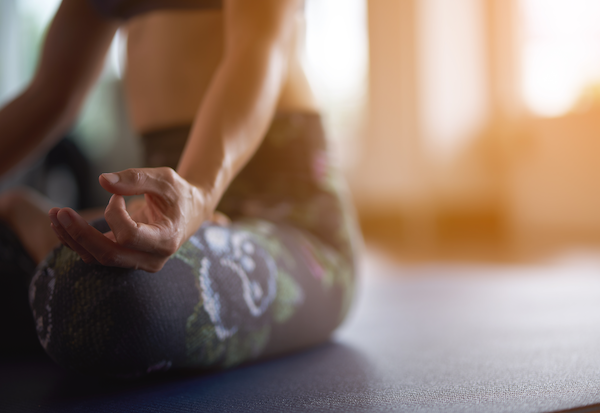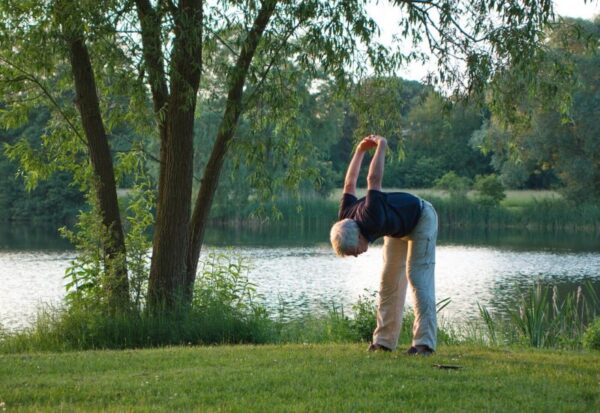
Hot Hatha Yoga is a type of yoga that is gaining popularity among yoga enthusiasts. It is a variation of traditional Hatha Yoga that is practiced in a heated room. Hot Hatha Yoga classes are usually 60 to 90 minutes long and consist of a series of postures and breathing exercises.
Do you want to find out everything about this yoga practice? Keep reading!
Table of Contents
What Is Hatha Yoga?
Hatha yoga is a type of yoga that focuses on physical postures (asanas) and breathing techniques (pranayama) to promote physical and mental wellness. It is a traditional form of yoga that has been practiced for centuries in India.
The word “hatha” comes from two Sanskrit words, “ha” and “tha,” which mean sun and moon, respectively. This reflects the balance that is sought in hatha yoga between opposing energies, such as strength and flexibility, effort and surrender, and activity and rest.
One of the most well-known practitioners of hatha yoga is Bikram Choudhury, who developed the popular Bikram yoga style. This style is practiced in a heated room and consists of a set sequence of 26 postures and two breathing exercises.
While Bikram yoga is a popular form of hatha yoga, there are many other styles as well. Some of the most common styles include Iyengar, Ashtanga, and Vinyasa yoga. Each style has its own unique emphasis on postures, breathing, and meditation.
Overall, hatha yoga is a great way to improve physical strength and flexibility, reduce stress and anxiety, and promote overall health and wellness.
What is Hot Hatha Yoga?
Hot Hatha Yoga is a type of yoga that is also performed in a heated room, and that combines traditional Hatha yoga and hot yoga. The room is heated to a temperature of around 105 degrees Fahrenheit (40 degrees Celsius) with a humidity level of 40%. The heat and humidity help to increase flexibility and allow the muscles to stretch more easily.
During a Hot Hatha Yoga class, participants perform a series of asanas while focusing on their breath. The poses are held for a longer period of time than in a traditional yoga class, which helps to build strength and endurance. The practice also includes pranayama, or breathing exercises, which help to calm the mind and reduce stress.
Hot Hatha Yoga is suitable for all levels, from beginners to advanced practitioners. The heat and humidity can be challenging, so it is important to stay hydrated and take breaks when needed. Participants should wear comfortable, breathable clothing and bring a towel and water bottle to class.
Origins of Hot Hatha Yoga
Hot Hatha Yoga is a relatively new style of yoga that has gained popularity in recent years. The origins of can be traced back to Bikram Choudhury, who developed the style in the 1970s.
Bikram Choudhury’s style of yoga is based on the principles of Hatha Yoga but with a twist. He developed a series of 26 postures and two breathing exercises that are performed in a room heated to 105 degrees Fahrenheit with a humidity of 40%. The heat is intended to help the body detoxify and increase flexibility, while the postures and breathing exercises promote strength, balance, and relaxation.
Understanding the Practice
The Yoga Room
The yoga room is typically heated to a temperature of around 95-105 degrees Fahrenheit (35 – 40 degrees Celsius). This temperature is designed to help warm up the muscles and increase flexibility. The humidity in the room is also increased to help promote sweat and detoxification.
The Yoga Poses
The yoga poses are similar to those in traditional Hatha Yoga. Some of the most common poses include Surya Namaskar, Adho Mukha Svanasana, Standing Forward Bend, and the Bridge Pose. These poses are designed to help practitioners improve their flexibility, strength, and balance.
The Yoga Flow
The yoga flow is typically slower and more deliberate than in other types of yoga such as Vinyasa. This slower pace allows practitioners to focus on their breath and the alignment of their postures. The flow is often structured around a series of standing, seated, and supine poses.
The Yoga Pace
The yoga pace is also slower than in other types of yoga. This slower pace allows practitioners to focus on their breath and the alignment of their postures. The pace is often structured around a series of standing, seated, and supine poses.
Benefits of Hot Hatha Yoga
Physical Benefits
The heat in the room helps to increase flexibility and strength. The practice also improves balance and coordination. The heat also helps to increase heart rate, which provides a cardiovascular workout. The practice can also help to improve lung function, as the heat makes it easier to breathe deeply.
This type of yoga is also an effective way to burn calories. The practice can burn up to 500 calories per hour, which can help to improve metabolism and promote weight loss. The practice also helps to increase bone density, which can help to prevent osteoporosis.
Mental Benefits
The practice helps to reduce stress and anxiety and can improve mood and reduce depressive symptoms. The practice also helps to improve focus and concentration.
The heat in the room can also help to release endorphins, which are natural mood boosters. Sweating during the practice can also help to release toxins and improve overall health.
Spiritual Benefits
Hot Hatha Yoga is also a spiritual practice that can help to promote stress management and detoxification. The practice helps to bring the mind, body, and spirit into balance. The heat in the room can help to release tension and promote relaxation. The practice also helps to improve overall well-being and promote a sense of inner peace.
Hot Hatha Yoga for Beginners
Starting Your Practice
Before starting your practice, it is essential to prepare yourself mentally and physically. Beginners should arrive at the yoga class early to set up their yoga mats and get familiar with the studio. It is also recommended to wear comfortable clothing that allows for a full range of movements.
During the class, the instructor will guide you through a series of yoga poses that are designed to align your body and calm your mind. It is essential to listen to your body and take breaks when needed. Beginners should focus on their breath and avoid pushing themselves too hard.
Essential Yoga Poses for Beginners
Hot Hatha Yoga for beginners typically includes a sequence of essential yoga poses that are designed to improve flexibility, strength, and balance. Some of the most common yoga poses for beginners include:
- Mountain pose (Tadasana)
- Downward-Facing Dog (Adho Mukha Svanasana)
- Warrior I (Virabhadrasana I)
- Warrior II (Virabhadrasana II)
- Triangle Pose (Trikonasana)
- Child’s Pose (Balasana)
- Corpse Pose (Savasana)
These poses are typically done in a specific sequence, with each pose building on the previous one. The instructor will guide you through each pose, ensuring that you are using proper alignment and breathing techniques.
Hot Hatha Yoga is an excellent way for beginners to experience the benefits of yoga in a challenging but supportive environment. With regular practice, beginners can improve their strength, flexibility, and overall well-being.
Hot Hatha Yoga for Different Groups
Hot Hatha Yoga for Older Adults
Older adults can benefit greatly from practicing Hot Hatha Yoga. The heat helps to increase blood flow and circulation, which can help to reduce joint pain and stiffness. However, it is important for older adults to be aware of their limitations and to practice with caution. They should avoid pushing themselves too hard and should take breaks when needed.
Hot Hatha Yoga for Pregnant Women
Pregnant women can also practice Hot Hatha Yoga, but they should take extra precautions. It is important for pregnant women to stay hydrated and to avoid overheating. They should also avoid certain postures that could be harmful to the baby. Prenatal yoga classes may be a better option for pregnant women, as these classes are specifically designed for expectant mothers.
In conclusion, Hot Hatha Yoga can be a beneficial practice for many different groups of people. However, it is important to take extra precautions when practicing in a heated environment. Older adults should practice with caution and avoid pushing themselves too hard. Pregnant women should take extra care to stay hydrated and avoid overheating. By practicing safely and mindfully, anyone can enjoy the benefits of Hot Hatha Yoga.
Hot Hatha Yoga vs Other Yoga Styles
Hot Hatha Yoga is a popular yoga style that is practiced in a heated room. It combines the traditional Hatha Yoga postures with the benefits of heat. While it shares some similarities with other yoga styles, there are some key differences that set it apart.
Hot Hatha Yoga vs Bikram Yoga
While both styles are practiced in a heated room, Bikram Yoga is a set sequence of postures that is the same in every class, while Hot Hatha Yoga allows for more variation in the postures and sequences.
Hot Hatha Yoga vs Vinyasa
Vinyasa Yoga is a yoga style that is characterized by flowing movements that are synchronized with the breath. It is often referred to as “flow” yoga because of the continuous movement from one pose to another.
While both styles can be practiced in a heated room, Vinyasa Yoga is more focused on movement and flow, while Hot Hatha Yoga is more focused on holding poses and building strength.
Hot Hatha Yoga vs Ashtanga
Ashtanga Yoga is a yoga style that is characterized by a set sequence of postures that are performed in a specific order. It is a physically demanding yoga style that is designed to build strength, flexibility, and stamina.
While both styles can be practiced in a heated room, Ashtanga Yoga is a set sequence of postures that is the same in every class, while Hot Hatha Yoga allows for more variation in the postures and sequences.
Hot Hatha Yoga Community and Lifestyle
Hot Hatha Yoga is more than just a physical exercise, it’s a community and lifestyle. Practitioners of Hot Hatha Yoga often describe it as a transformative experience that goes beyond the mat. The community aspect is a significant part of the Hot Hatha Yoga lifestyle, and it’s often what draws people to the practice.
In Hot Hatha Yoga classes, participants share a space and work together to achieve their individual goals. This sense of community can be seen before and after class when students chat with each other and the instructors. It’s not uncommon for people to make new friends and even find romantic partners through Hot Hatha Yoga.
Hot Hatha Yoga instructors play a significant role in building and maintaining this community. They often act as mentors and guides, providing emotional support and encouraging students to push themselves further. Instructors also create a welcoming and inclusive environment that makes everyone feel comfortable and safe.
The Hot Hatha Yoga lifestyle goes beyond the studio. Many practitioners incorporate mindfulness practices, such as meditation and breathing exercises, into their daily routines. They also prioritize wellness and self-care, making sure to eat healthy foods, get enough sleep, and take care of their mental health.
Before you go…
We hope this guide has been helpful. If you are interested in discovering other types of yoga styles, you should check out one of the following articles, or just go to our Yoga Types category 🙂
- Candlelight Restorative Yoga: A Guide to Relaxation and Renewal
- Acro Yoga Beginner Guide: Tips and Tricks and 5 Popular Poses
- Aqua Yoga: Main Benefits and Best 5 Poses For Beginners
Namaste!



